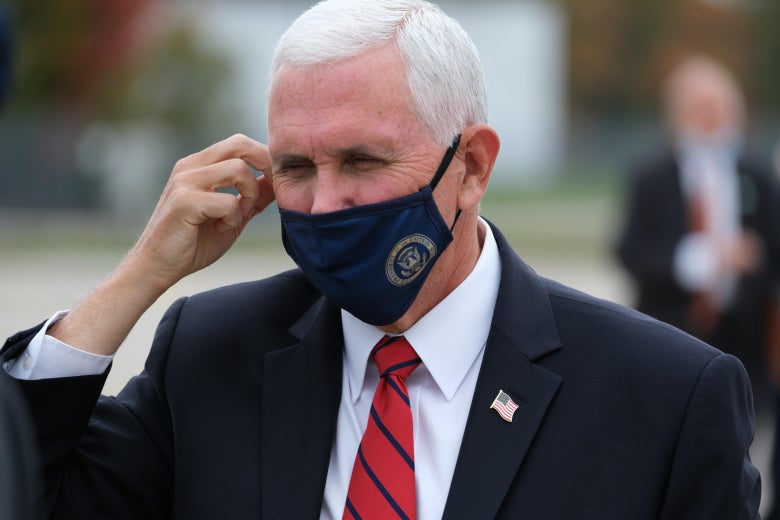
Eva Claire Hambach/AFP via Getty Images
When conversation at the the vice presidential debate on Wednesday turned to the coronavirus, Mike Pence pivoted from defense to offense by pillorying Joe Biden and Barack Obama’s response to the 2009 H1N1 pandemic, also known as the swine flu. He depicted the previous administration’s swine flu response as lackluster and used that as proof that a president Biden would not be competent in shepherding the country through the COVID-19 pandemic. Here’s a clip of his remarks:
Trump has long used H1N1 as a cudgel to counter the Biden campaign’s central argument that there’s a dire need for a new and more competent administration to take the reins of the U.S.’s coronavirus response. Even in March, when COVID-19 was first spreading widely, Trump falsely claimed that Obama “didn’t do anything” about swine flu. The president began reupping this line of attack after Pence brought up H1N1 in the debate, casting the 2009 pandemic as “one of the great disasters.”
But the Obama administration’s response to the swine flu wasn’t the calamity that Trump and Pence have made it seem.
During the debate, Pence noted that 60 million Americans contracted H1N1 and said, “If the swine flu had been as lethal as the coronavirus in 2009 when Joe Biden was vice president, we would’ve lost 2 million American lives.” The thing is that the federal government under Obama knew that swine flu was rarely lethal at the time and factored that fact into its decision-making in order to ensure that there wouldn’t be much disruption to the economy. (The mortality rate for H1N1 was 0.02 percent, while the mortality rate for COVID-19 is 0.65 percent.) It helped that H1N1 was an influenza, which doctors are very familiar with.
Some medical experts actually criticized Obama for being too proactive about the swine flu given how mild it was. Conservatives went further to accuse him of overhyping the disease as a part of a cynical ploy to pass health care reforms. “Create panic and chaos, sell health care, keep general unrest out there amongst the population—it’s right out the Obama formula,” radio host Rush Limbaugh said in October 2009 in reaction to the then-president declaring a national emergency for the H1N1 pandemic. The eventual U.S. death toll—12,469 people—fell well below the 30,000 to 90,000 people that the President’s Council of Advisers on Science and Technology initially estimated might die.
As infectious disease specialist Kent Sepkowitz wrote in Slate in March:
We knew how to diagnose and treat H1N1, even if it was different than normal. Clinicians did not require much help outside of the ordinary—though we got it, maybe too much. In contrast, the current governmental response to COVID-19 is disorganized, disinterested, dishonest, and, worst of all, cruel to everyone in the country.
Trump has known how lethal the coronavirus is since at least early February. He told journalist Bob Woodward in a Feb. 7 interview that COVID-19 could be five times “more deadly” than the seasonal flu, even as he publicly downplayed the threat of the illness. So while the Obama administration was accused of being too alarmist about a not-very-lethal pandemic, the Trump administration has not been alarmist enough about a fairly lethal pandemic.
One of the most damning statistics for the Trump administration’s coronavirus response, which moderator Susan Page referred to in Wednesday’s debate, is the number of fatalities in the U.S. compared with the rest of the world. The U.S. death toll as a percentage of our population is higher than that of almost any other wealthy nation. The U.S., which accounts for 4 percent of the world’s population, has been home to roughly 20 percent of the world’s reported coronavirus deaths. (There have been more than 210,000 coronavirus deaths in the U.S., while the global death toll recently surpassed 1 million.) Now let’s look at the swine flu. The Centers for Disease Control and Prevention reports that 12,469 people died from H1N1 in the U.S. The agency also estimated that somewhere between 151,700 and 575,400 people died from the illness worldwide. That’s a pretty big range, but even if we assumed that the lower end of that estimate is more accurate, then Americans only accounted for about 8 percent of the world’s swine flu deaths. If we take the higher end for granted, then Americans only accounted for 2 percent of the world death toll.
Did the Obama administration make mistakes with H1N1? Certainly. The U.S. may have been able to spot the virus earlier if it had better communication with Mexico, where the pandemic originated. The administration also overpromised when it came to vaccines, predicting in the summer of 2009 that it would have 160 million doses by the following October. When it ended up only delivering 30 million, the censure from Congress and the public was swift. Yet the administration’s errors didn’t result in the overwhelming loss of life we’re witnessing now.
In fact, even Trump praised Obama’s handling of the swine flu at the time. In a 2009 Fox New interview, Trump said of the Obama administration’s measures, “It’s going to be handled. It’s going to come. It’s going to be bad. And maybe it will be worse than the normal flu seasons. And it’s going to go away. I think it is being handled fine. I think the words are right.”